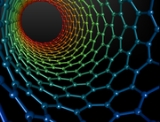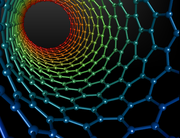
Timeline of carbon nanotubes
Encyclopedia
 |
1952
- Radushkevich and Lukyanovich publish a paper in the Soviet Journal of Physical Chemistry showing hollow graphitic carbon fibers that are 50 nanometers in diameter.
1960
- Bollmann and Spreadborough discuss friction properties of carbon due to rolling sheets of graphene in Nature. Electron Microscope picture clearly shows MWCNT
1976
- Oberlin, Endo and Koyama report CVD (Chemical Vapor Deposition) growth of nanometer-scale carbon fibers.
1979
- Arthur C. ClarkeArthur C. ClarkeSir Arthur Charles Clarke, CBE, FRAS was a British science fiction author, inventor, and futurist, famous for his short stories and novels, among them 2001: A Space Odyssey, and as a host and commentator in the British television series Mysterious World. For many years, Robert A. Heinlein,...
's science fiction novel The Fountains of ParadiseThe Fountains of ParadiseThe Fountains of Paradise is a Hugo and Nebula Award–winning 1979 novel by Arthur C. Clarke. Set in the 22nd century, it describes the construction of a space elevator. This "orbital tower" is a giant structure rising from the ground and linking with a satellite in geostationary orbit at the...
popularizes the idea of a space elevatorSpace elevatorA space elevator, also known as a geostationary orbital tether or a beanstalk, is a proposed non-rocket spacelaunch structure...
using "a continuous pseudo-one dimensional diamond crystal".
1987
- Howard G. Tennent of Hyperion Catalysis issued a U.S. patent for graphitic, hollow core "fibrils".
1991
- Nanotubes discovered in the soot of arc discharge at NEC, by Japanese researcher Sumio IijimaSumio IijimaSumio Iijima is a Japanese physicist, often cited as the discoverer of carbon nanotubes. Although carbon nanotubes had been observed prior to his "discovery", Iijima's 1991 paper generated unprecedented interest in the carbon nanostructures and has since fueled intense research in the area of...
. - August — Nanotubes discovered in CVD by Al Harrington and Tom Maganas of Maganas Industries, leading to development of a method to synthesize monomolecular thin film nanotube coatings.
1992
- First theoretical predictions of the electronic properties of single-walled carbon nanotubes by groups at Naval Research Laboratory, USA; Massachusetts Institute of TechnologyMassachusetts Institute of TechnologyThe Massachusetts Institute of Technology is a private research university located in Cambridge, Massachusetts. MIT has five schools and one college, containing a total of 32 academic departments, with a strong emphasis on scientific and technological education and research.Founded in 1861 in...
; and NEC Corporation
1993
- Groups led by Donald S. Bethune at IBM and Sumio IijimaSumio IijimaSumio Iijima is a Japanese physicist, often cited as the discoverer of carbon nanotubes. Although carbon nanotubes had been observed prior to his "discovery", Iijima's 1991 paper generated unprecedented interest in the carbon nanostructures and has since fueled intense research in the area of...
at NEC independently discover single-wall carbon nanotubes and methods to produce them using transition-metal catalysts.
1995
- Swiss researchers are the first to demonstrate the electron emission properties of carbon nanotubes. German inventors Till Keesmann and Hubert Grosse-Wilde predicted this property of carbon nanotubes earlier in the year in their patent application.
1997
- First carbon nanotube single-electron transistors (operating at low temperature) are demonstrated by groups at Delft University and UC Berkeley.
- The first suggestion of using carbon nanotubes as optical antennas is made in the patent application of inventor Robert Crowley filed in January 1997.
1998
- First carbon nanotube field-effect transistors are demonstrated by groups at Delft University and IBMIBMInternational Business Machines Corporation or IBM is an American multinational technology and consulting corporation headquartered in Armonk, New York, United States. IBM manufactures and sells computer hardware and software, and it offers infrastructure, hosting and consulting services in areas...
.
2001
- April — first report on a technique for separating semiconducting and metallic nanotubes.
2002
- January — Multi-walled nanotubes demonstrated to be fastest known oscillators (> 50 GHz).
2003
- September — NEC announced stable fabrication technology of carbon nanotube transistors
2004
- March — Nature published a photo of an individual 4 cm long single-wall nanotube (SWNT).
2005
- May — A prototype high-definition 10-centimetre flat screen made using nanotubes was exhibited.
- August — University of California finds Y-shaped nanotubes to be ready-made transistors.
- August — General ElectricGeneral ElectricGeneral Electric Company , or GE, is an American multinational conglomerate corporation incorporated in Schenectady, New York and headquartered in Fairfield, Connecticut, United States...
announced the development of an ideal carbon nanotube diodeDiodeIn electronics, a diode is a type of two-terminal electronic component with a nonlinear current–voltage characteristic. A semiconductor diode, the most common type today, is a crystalline piece of semiconductor material connected to two electrical terminals...
that operates at the "theoretical limit" (the best possible performance). A photovoltaic effectPhotovoltaic effectThe photovoltaic effect is the creation of voltage or electric current in a material upon exposure to light. Though the photovoltaic effect is directly related to the photoelectric effect, they are different processes. In the photoelectric effect, electrons are ejected from a material's surface...
was also observed in the nanotube diode device that could lead to breakthroughs in solar cellSolar cellA solar cell is a solid state electrical device that converts the energy of light directly into electricity by the photovoltaic effect....
s, making them more efficient and thus more economically viable. - August — Nanotube sheet synthesised with dimensions 5 × 100 cm.
2006

- March — IBM announces that they have built an electronic circuit around a CNT.
- March — Nanotubes used as a scaffold for damaged nerve regeneration.
- May — Method of placing nanotube accurately is developed by IBM.
- June — Gadget invented by Rice University that can sort nanotubes by size and electrical properties
- July — Nanotubes were alloyed into the carbon fiberCarbon fiberCarbon fiber, alternatively graphite fiber, carbon graphite or CF, is a material consisting of fibers about 5–10 μm in diameter and composed mostly of carbon atoms. The carbon atoms are bonded together in crystals that are more or less aligned parallel to the long axis of the fiber...
bike that won the 2006 Tour de France2006 Tour de FranceThe 2006 Tour de France was the 93rd Tour de France, taking place from July 1 to July 23, 2006. It was won by Óscar Pereiro following the disqualification of apparent winner Floyd Landis....
.
External links
- New ScientistNew ScientistNew Scientist is a weekly non-peer-reviewed English-language international science magazine, which since 1996 has also run a website, covering recent developments in science and technology for a general audience. Founded in 1956, it is published by Reed Business Information Ltd, a subsidiary of...
— Special Report on Nanotechnology

